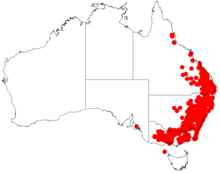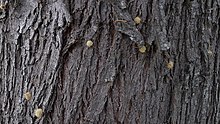
Acacia saligna, commonly known by various names including coojong, golden wreath wattle, orange wattle, blue-leafed wattle, Western Australian golden wattle, and, in Africa, Port Jackson willow, is a small tree in the family Fabaceae. Native to Australia, it is widely distributed throughout the south west corner of Western Australia, extending north as far as the Murchison River, and east to Israelite Bay. The Noongar peoples know the tree as Cujong.
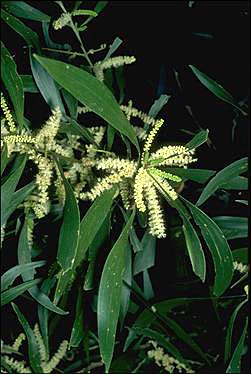
Acacia maidenii, also known as Maiden's wattle, is a tree native to Australia. It has been introduced into India, and Argentina, and it grows on plantations in South Africa.

Acacia melanoxylon, commonly known as the Australian blackwood, is an Acacia species native in South eastern Australia. The species is also known as blackwood, hickory, mudgerabah, Tasmanian blackwood, or blackwood acacia. The tree belongs to the Plurinerves section of Acacia and is one of the most wide-ranging tree species in eastern Australia and is quite variable mostly in the size and shape of the phyllodes.

Acacia mearnsii, commonly known as black wattle, late black wattle or green wattle, is a species of flowering plant in the family Fabaceae and is endemic to south-eastern Australia. It is usually an erect tree with smooth bark, bipinnate leaves and spherical heads of fragrant pale yellow or cream-coloured flowers followed by black to reddish brown pods. In some other parts of the world, it is regarded as an invasive species.
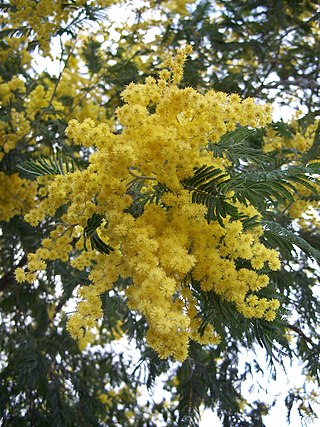
Acacia dealbata, the silver wattle, blue wattle or mimosa, is a species of flowering plant in the legume family Fabaceae, native to southeastern Australia in New South Wales, Victoria, Tasmania, and the Australian Capital Territory, and widely introduced in Mediterranean, warm temperate, and highland tropical landscapes.

Acacia salicina is a thornless species of Acacia tree native to Australia.

Acacia falcata, commonly known as sickle wattle and by other vernacular names including sally, is a perennial shrub or tree native to eastern Australia, which reaches five metres in height and has cream flowers in early winter. It gets its common and scientific name for its sickle-shaped leaves. Hardy and adaptable to cultivation, it is used in regeneration of bushland.

Acacia longifolia is a species of Acacia native to southeastern Australia, from the extreme southeast of Queensland, eastern New South Wales, eastern and southern Victoria, southeastern South Australia, and Tasmania. Common names for it include long-leaved wattle, acacia trinervis, aroma doble, golden wattle, coast wattle, sallow wattle and Sydney golden wattle. It is not listed as being a threatened species, and is considered invasive in Portugal, New Zealand and South Africa. In the southern region of Western Australia, it has become naturalised and has been classed as a weed by out-competing indigenous species. It is a tree that grows very quickly reaching 7–10 m in five to six years.

Acacia mangium is a species of flowering tree in the pea family, Fabaceae, that is native to northeastern Queensland in Australia, the Western Province of Papua New Guinea, Papua, and the eastern Maluku Islands. Common names include black wattle, hickory wattle, mangium, and forest mangrove. Its uses include environmental management and wood.

Acacia pendula, commonly known as the weeping myall, true myall, myall, silver-leaf boree, boree, and nilyah, is a species of wattle, which is native to Australia. The 1889 book The Useful Native Plants of Australia records that common names included "Weeping Myall", "True Myall", and Indigenous people of western areas of New South Wales and Queensland referred to the plant as "Boree" and "Balaar".
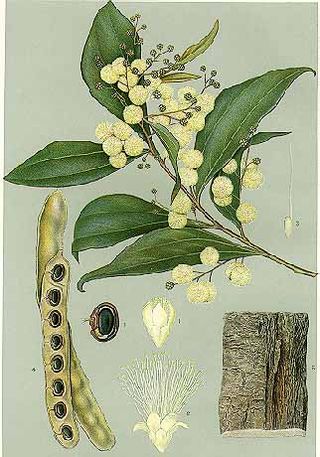
Acacia binervata, commonly known as two-veined hickory, is a shrub or tree that is endemic to eastern Australia.

Acacia pravissima, commonly known as Ovens wattle, Oven wattle, wedge-leaved wattle and Tumut wattle, is a species of flowering plant in the legume family Fabaceae. It is an evergreen shrub native to Victoria, the South West Slopes and Southern Tablelands of New South Wales, Australia.
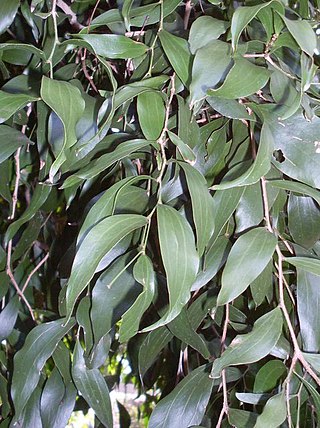
Acacia bakeri, known as the marblewood, white marblewood, Baker's wattle or scrub wattle, is one of the largest of all acacias, growing to 40 m (130 ft) tall. It is a long-lived climax rainforest tree from eastern Australia. Unlike most acacias, fire is not required for seed germination. This tree is considered vulnerable to extinction. Its former habitat is lowland sub tropical rainforest which has been mostly cleared in the 19th and 20th centuries.
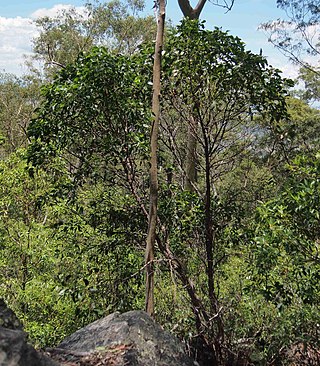
Acacia flavescens, also known as the red wattle, yellow wattle or primrose ball wattle, is a tree in the genus Acacia native to eastern Australia.

Acacia loderi, known colloquially as nelia or nealie, is a species of Acacia native to Australia.

Acacia jibberdingensis, also known as Jibberding wattle or willow-leafed wattle, is a shrub or tree belonging to the genus Acacia and the subgenus Juliflorae that is endemic to Western Australia.

Acacia iteaphylla, commonly known as Flinders Range wattle, Port Lincoln wattle, winter wattle and willow-leaved wattle, is a shrub belonging to the genus Acacia and the subgenus Phyllodineae that is endemic to South Australia.

Acacia shirleyi, known colloquially as lancewood, is a species of Acacia native to Queensland and the Northern Territory in Australia. It grows as a tree to 15 metres (49 ft) high, with dark grey or black stringy bark and blue-grey foliage. The yellow flowers appear from March to July. It grows in dry scrub, open forest or mixed savannah woodland. Indigenous people used the wood as fuel and to make hunting spears. Cattle can eat the foliage as fodder.
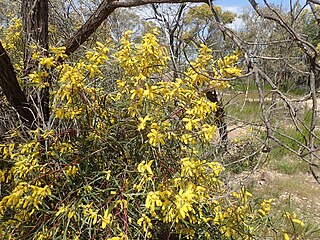
Acacia doratoxylon, commonly known as currawang, lancewood, spearwood or coast myall, is a shrub or tree belonging to the genus Acacia and the subgenus Juliflorae that is native to eastern and south eastern Australia.

Acacia tephrina, commonly known as boree, is a tree of the genus Acacia and the subgenus Plurinerves that is endemic to an area of north eastern Australia. It is rated as being of least concern according to Nature Conservation Act 1992.

